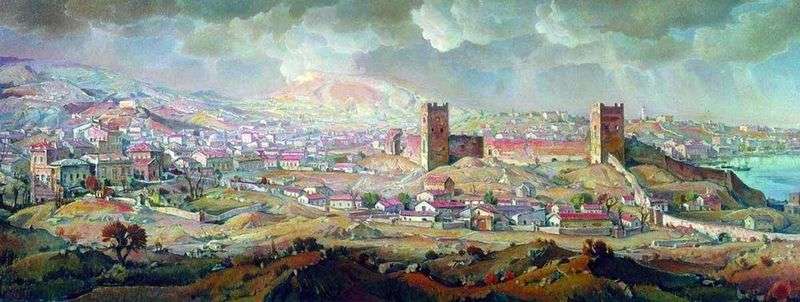
The low Feodosia hills, Genoese walls with watchtowers, the bay, the silhouette of the Bald Mountain, the low houses all this, alternately alternating, is located on a long canvas reproducing the panorama of the ancient city and its surroundings. The landscape was characterized by narrative, as Bogaevsky sought to preserve in it the authenticity of the layout and appearance of Theodosius. But the author used at the same time the expressive possibilities of pictorial means not just to write the natural kind, but to create a picture that has a peculiar originality. Its composition is inherent, for example, internal dynamics: the stagnation of architectural forms animates the movement of clouds scattered in the sky and the rhythmic alternation of residential buildings, yellow hills and low mountains. In the monotony of squat stone houses, the Genoese citadel breaks in, proudly towering over the city. All the composition of the landscape “Feodosia” combines light and shade.
The foreground is written in a dense ink stroke, dark in color with a predominance of umbra and sienna. Behind him opens the middle, lighted, with residential houses and fortress walls painted in a pleasant light ocher color. The Genoese fortress, which plays the role of the semantic and compositional center of the picture, is given here by a darker, more contrasting spot on the light background of the mountains and subordinates to itself in tone the gradation of all the color elements of the canvas.
The third plan, with the Bald Mountain, the hills and the sea bay, is written in a lighter color with an introduction to the main warm brown-ohrist tone of blue and gray shades. The main color of the ocher land fits harmoniously into the differently colored plans of the picture.
But in some places red tiled roofs, white walls of houses, blue shadows falling from separate objects, break out from the general black and white field reaching the strength of the color spot, which indicates the artist’s use of two techniques – the light and shadow construction of the landscape coming from Shchedrin, and the picturesque principle of color relations, which is a sign of plein air painting, inherent in the art of a number of Russian artists of the late XIX-early XX century. Dominates, however, in this work of chiaroscuro. She is subject to the transfer of space, and as a whole the picture is solved by the vocal of close olive-brown tones, which gives her a colorful range some conditional restraint.

 (2 votes, average: 4.00 out of 5)
(2 votes, average: 4.00 out of 5)